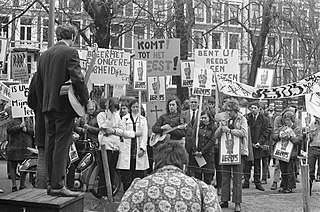Adventism is a branch of Protestant Christianity that believes in the imminent Second Coming of Jesus Christ. It originated in the 1830s in the United States during the Second Great Awakening when Baptist preacher William Miller first publicly shared his belief that the Second Coming would occur at some point between 1843 and 1844. His followers became known as Millerites. After Miller's prophecies failed, the Millerite movement split up and was continued by a number of groups that held different doctrines from one another. These groups, stemming from a common Millerite ancestor, collectively became known as the Adventist movement.
The Great Awakening was a series of religious revivals in American Christian history. Historians and theologians identify three, or sometimes four, waves of increased religious enthusiasm between the early 18th century and the late 20th century. Each of these "Great Awakenings" was characterized by widespread revivals led by evangelical Protestant ministers, a sharp increase of interest in religion, a profound sense of conviction and redemption on the part of those affected, an increase in evangelical church membership, and the formation of new religious movements and denominations.

The Second Great Awakening was a Protestant religious revival during the late 18th to early 19th century in the United States. It spread religion through revivals and emotional preaching and sparked a number of reform movements. Revivals were a key part of the movement and attracted hundreds of converts to new Protestant denominations. The Methodist Church used circuit riders to reach people in frontier locations.

The Jesus movement was an evangelical Christian movement that began on the West Coast of the United States in the late 1960s and early 1970s and primarily spread throughout North America, Europe, Central America, Australia and New Zealand, before it subsided in the late 1980s. Members of the movement were called Jesus people or Jesus freaks.
James Michael Palosaari was an American evangelist and performer, one of the leaders in the Jesus Movement of the late 1960s and 1970s.

The Bruderhof is a communal Anabaptist Christian movement that was founded in Germany in 1920 by Eberhard Arnold. The movement has communities in the United States, the United Kingdom, Germany, Austria, Paraguay, South Korea and Australia. The Bruderhof practises believer's baptism, non-violence and peacemaking, common ownership, the proclamation of the gospel, and lifelong faithfulness in marriage. The Bruderhof is an intentional community as defined by the Fellowship for Intentional Community.

Calvary Chapel is an international association of charismatic evangelical churches, with origins in Pentecostalism. It maintains a number of radio stations around the world and operates many local Calvary Chapel Bible College programs.

An intentional community is a voluntary residential community which is designed to have a high degree of social cohesion and teamwork. The members of an intentional community typically hold a common social, political, religious, or spiritual vision, and typically share responsibilities and property. This way of life is sometimes characterized as an "alternative lifestyle". Intentional communities can be seen as social experiments or communal experiments. The multitude of intentional communities includes collective households, cohousing communities, coliving, ecovillages, monasteries, survivalist retreats, kibbutzim, Hutterites, ashrams, and housing cooperatives.

Lonnie Ray Frisbee was an American Charismatic evangelist in the late 1960s and in the 1970s; he was a self-described "seeing prophet". He was known for his hippie appearance. He was notable as a minister and evangelist in the Jesus movement.
The Jesus Army, also known as the Jesus Fellowship Church and the Bugbrooke Community, was a neocharismatic evangelical Christian movement based in the United Kingdom, part of the British New Church Movement. The name Jesus Army was specifically used for the outreach and street-based evangelism for which they were known.
The Latter Rain, also known as the New Order or the New Order of the Latter Rain, was a post-World War II movement within Pentecostal Christianity which remains controversial. The movement saw itself as a continuation of the restorationism of early Pentecostalism. The movement began with major revivals between 1948 and 1952 and became established as a large semi-organized movement by 1952. It continued into the 1960s. The movement had a profound impact on subsequent movements as its participants dispersed throughout the broader charismatic and Pentecostal movements beginning in the 1960s.
The Shepherding movement was an influential and controversial movement within some British, Australian and American charismatic churches. It emerged in the 1970s and early 1980s. The doctrine of the movement emphasized the "one another" passages of the New Testament, and the mentoring relationship described in the Second Epistle to Timothy.

People of Praise is a network of lay Christian intentional communities. As a parachurch apostolate, membership is open to any baptized Christian who affirms the Nicene Creed and agrees to the community's covenant. The majority of its members are Catholics, but Protestants can also join, reflecting the ecumenical nature of People of Praise. It has 22 branches in the United States, Canada, and the Caribbean, with approximately 1,700 members. It founded Trinity Schools, which are aligned with the philosophy of classical Christian education.
The House of Miracles was a series of Christian communal houses established during the early Jesus Movement under the auspices of Pastor Chuck Smith and Calvary Chapel in Costa Mesa, California. The House of Miracles was the group from which sprang the largest of the Jesus People communal groups, the Shiloh Youth Revival Centers, which had 100,000 members and 175 communal houses spread across the United States and Canada during its lifespan.
Calvary Chapel Costa Mesa is a Christian megachurch located near the boundary between the cities of Costa Mesa and Santa Ana in Orange County. Although the church takes its name from its original facilities on the Costa Mesa side of the boundary, it is now in Santa Ana. The original Calvary Chapel, the church has grown since 1965 from a handful of people, led by senior pastor Chuck Smith, to become the "mother church" of over one thousand congregations worldwide. Outreach Magazine's list of the 100 Largest Churches in America lists attendance as 9,500, making it the thirty-ninth largest in America.
Woman's Missionary Union (WMU) is an auxiliary of the Southern Baptist Convention that was founded in 1888. It is the largest Protestant missions organization for women in the world.
Erskine Leo Holt was Christian minister, missionary and religious leader who established many independent House Church communities throughout the United States. He was one of the founders of the Pan-American Mission and later founded Corvilla, a Christian retreat center in Zephyrhills, Florida.

A Christian music festival is a music festival held by the Christian community, in support of performers of Christian music. The festivals are characterized by more than just music; many feature motivational speakers and evangelists, and include seminars on Christian spiritual and missions topics, service, and evangelism. They are often viewed as evangelical tools, and small festivals can draw 10 times the crowd of traditional revival meetings. While the central theme of a Christian festival is Jesus Christ, the core appeal of a Christian music festival remains the artists and their music. Critics point out that the dichotomy of business and religious interests can be problematic for Christian festivals. In similar ways as the Christian music industry in general, festivals can be drawn away from their central theme and gravitate toward commercialization and mainstream acts in an attempt to draw crowds.
Shiloh House may refer to:

Jesus Youth(JY) is an International Catholic Movement, approved by the Holy See.









